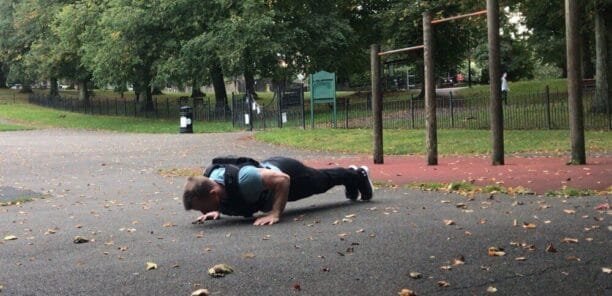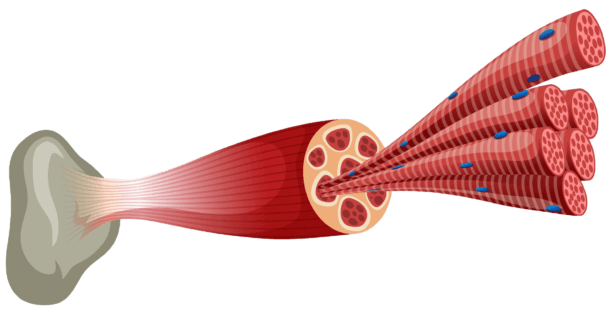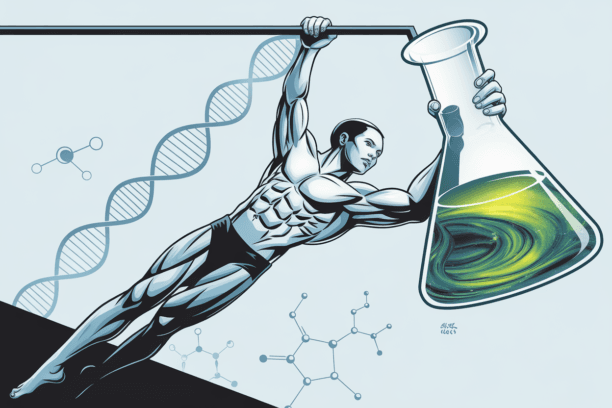Have you ever wondered why so many calisthenics athletes have great physiques?
As someone who’s spent years experiencing and studying the transformative effects of calisthenics, I can tell you that the science behind muscle growth through bodyweight training is fascinating. While many believe you need heavy weights to build serious muscle, the scientific evidence tells a different story. Let me break down what has worked for me and exactly how your body builds muscle through calisthenics, backed by the latest research and practical experience.
In essence, to build muscle with calisthenics you will need to ensure you are:
- Providing enough stimulus to the muscle for growth
- Have adequate nutrition to provide the body with the necessary building blocks to create more muscle
- Ensure you allow your body to rest enough for growth to occur
This is put simply by renowned bodybuilder Mike Mentzer, who stated:
“You must understand that the workout does not actually produce muscular growth. The workout is merely a trigger that sets the body’s growth mechanism into motion. It is the body itself, of course, that produces growth; but it does so only during a sufficient rest period.”
I have found by sticking to the key principles, these can applied to calisthenics to achieve some serious muscle growth and size over time.
Table of Contents
Understanding Muscle Hypertrophy Mechanisms
Mechanical Tension as the Primary Driver of Muscle Growth
Through my experience and research, I’ve discovered that mechanical tension is the primary trigger for hypertrophy. This study from the Journal of Strength and Conditioning Research also supports my experience.
I like to provide the necessary mechanical tension by picking an exercise or variation that is challenging enough where I will hit failure between 8-15 repetitions.
As explained in our comprehensive guide to building muscle with calisthenics, you can create significant mechanical tension without external weights. When performing exercises like planche leans or front lever holds, your muscles experience intense mechanical loading that signals growth.
Role of Metabolic Stress in Calisthenics Exercises
Metabolic stress plays a crucial role in muscle growth during calisthenics training. Our hypertrophy-focused workout plan shows how exercises like high-volume push-ups or pull-ups create substantial metabolic stress through the accumulation of metabolites, triggering muscle growth.
Muscle Damage and Repair Process
Each time you workout hard enough, this creates small micro tears in your muscle. And it is these micro muscle tears that heal and get stronger over time.
The controlled muscle damage from calisthenics workouts initiates a powerful repair response. To ensure you are consistently pushing yourself hard enough while working out. You will want to progressively overload the muscle. As you incrementally increase the difficulty to meet to increased muscle capability, you can then consistently create microscopic tears that lead to muscle growth.
Key Scientific Principles of Calisthenics Growth

Applying these key principles ensures muscle growth. This study was performed to determine whether progressive calisthenic push-up training is comparable with traditional bench press training as a technique for increasing muscle strength and thickness.
The study found that “No significant differences were observed” as both the push up group and bench group had significantly increased their 1 rep max from baseline while following the key principles of muscle growth.
Progressive Overload Techniques in Bodyweight Exercises
Progressive overload in calisthenics requires creativity, but it’s absolutely achievable. Based on our progressive overload guide, I recommend:
- Increasing leverage difficulty through exercise progressions
- Adding range of motion to basic movements
- Manipulating tempo for greater muscle tension
- Adding external weight to calisthenics exercises
- Strategic volume increases
Time Under Tension Manipulation
Time under tension is crucial for muscle growth. Ensure you are:
- Using controlled negatives
- Incorporating isometric holds
- Performing smooth, controlled movements
- Adding pause reps at points of maximum tension
Performing these will ensure you are actually hitting the muscle, rather than just ‘going through the motions’.
Motor Unit Recruitment in Compound Movements
Calisthenics exercises excel at recruiting multiple muscle groups simultaneously. As most calisthenics exercises are compound movements. Advanced movements like front levers and planche progressions activate more motor units than many isolated weight training exercises.
Optimizing Training Variables for Hypertrophy

Optimizing your training variables is a sliding scale. As if one variable increases, you can expect another variable to decrease. The more frequently you train, the less intense those trainings should be. As if you were simply training everyday, performing 10 sets to complete failure. Your body would not have adequate time to grow and the fatigue would catch up with you very quick.
Volume and Frequency Considerations
Based on our progression guidelines, optimal muscle growth requires:
- 10-20 sets per muscle group per week
- Training each muscle group 2-3 times weekly
- Adjusting volume based on exercise intensity
- Strategic deload periods every 4-6 weeks
While there are some standard recommendations on reps, sets and frequency. I invite you to experiment for what works best for you specifically as I have found training each muscle once per week, with only 4-6 sets to failure work best for me to consistently improve.
Rest Periods and Recovery
Proper rest is crucial for muscle growth.
- Rest 90-180 seconds between sets for compound movements
- Take 60-90 seconds for basic exercises
- Allow 2-3 minutes when training near failure
- Prioritize 7-9 hours of quality sleep nightly
Exercise Selection and Muscle Fiber Recruitment
For maximum muscle growth, our complete exercise guide recommends including:
- Straight arm exercises for unique activation patterns
- Bent arm movements for traditional strength work
- A mix of pushing and pulling movements
- Exercises targeting both fast and slow-twitch muscle fibers
Nutrition Science for Calisthenics Hypertrophy

Providing your body with the correct nutrition is essential for building muscle with calisthenics. What you eat is the building blocks, allowing your body to build that muscle size and strength.
Protein Requirements for Muscle Synthesis
Following our comprehensive nutrition guide, optimal protein intake includes:
- 1.6-2.2g of protein per kg of bodyweight daily
- Protein distribution across 3-5 meals
- High-quality protein sources
- Strategic supplementation when needed
Energy Balance and Muscle Growth
As detailed in our muscle-building diet guide, you need:
- Caloric surplus of 10-20% above maintenance
- Balanced macronutrient ratios
- Adequate carbohydrates for performance
- Essential fats for hormone production
Supplementation Considerations
While supplements are not necessary. They can be an addition if you have having trouble getting in enough protein or other dietary needs.
You could try to supplement your diet with:
- Creatine monohydrate (5g daily)
- Quality protein powder when needed
- Essential fatty acids
- Basic micronutrient support
Advanced Training Strategies

Advanced training strategies can be often thought as the missing link for many beginners. However this is severely wrong. The way calisthenics athletes get to becoming advanced is not necessarily using advanced techniques. It is by mastering the basics. It is only when the basics do not work as well, or the body needs different stimuluses to shock the system, will these advanced training strategies be used.
I recommend if you are within your first 2 years of training, that you follow our progressive overload roadmap, as this will
Breaking Through Plateaus
When progress stalls, you can implement these strategies to help provide a new stimulus to the body:
- Adjust leverage in basic movements
- Incorporate drop sets and supersets
- Use tempo manipulation
- Add weighted calisthenics when appropriate
Recovery and Adaptation

Sleep and recovery is often overlooked when it comes to building muscle. However, it plays a critical component as it is during these periods that the body repairs and strengthens muscle fibers, replenishes energy stores, and balances hormones essential for muscle growth and overall health.
Adequate rest not only enhances physical performance but also supports mental well-being, reducing the risk of overtraining and injury.
Incorporating effective recovery strategies, such as proper nutrition, hydration, and active rest, can significantly improve adaptation to training stimuli, allowing you to achieve your fitness goals more efficiently and sustainably.
Sleep Optimization
Following our sleep optimization research, prioritize:
- 7-9 hours of quality sleep
- Consistent sleep schedule
- Dark, cool sleeping environment
- Pre-bed relaxation routine
Active Recovery Methods
Based on our recovery guidelines, implement:
- Light mobility work between sessions
- Strategic deload weeks
- Proper warm-up and cool-down routines
- Stress management techniques
Conclusion
The science behind muscle hypertrophy in calisthenics is clear – you can build significant muscle using bodyweight exercises when you understand and apply these principles correctly. For a complete approach to your training, check out our Ultimate Guide to Building Muscle with Calisthenics.
Frequently Asked Questions
Can you build significant muscle mass with just calisthenics?
How long does it take to see muscle growth with calisthenics?
Is weight training necessary to supplement calisthenics?
What’s the best way to start building muscle with calisthenics?
Related Articles:

Founder of www.calisthenics-101.co.uk. Training calisthenics since 2012.
Currently working on: 30 second one-arm handstand, muscle-up 360, straddle planche.
